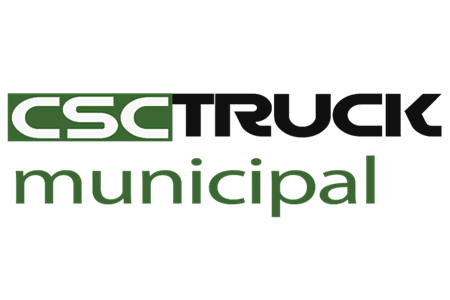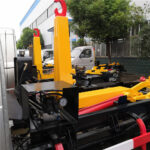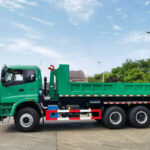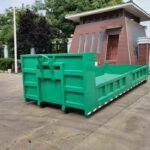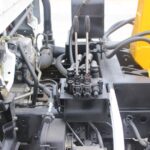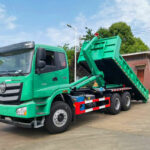1. Fundamental Mechanics & Operational Philosophies
Defining Core Operational DNA
The choice between these systems hinges on fundamentally different approaches to material handling. Traditional roll-off systems rely on a winch-and-cable mechanism to drag containers onto tilted beds—a process demanding 50-100 feet of linear clearance and creating significant ground pressure during loading. Conversely, the skip loader garbage truck (synonymous with hook loader garbage truck) employs a hydraulic hook-arm system engaging precisely engineered container pins for vertical lifting. This eliminates the drag friction inherent in roll-offs, reducing energy expenditure by 30-40% per cycle while enabling true multi-plane container manipulation—critical when operating within alleyways constrained by overhanging utilities or flanked by parked vehicles. The mechanical distinction manifests most profoundly in high-cycle urban environments where speed, spatial efficiency, and equipment longevity dictate total cost of ownership.
The Physics of Material Engagement
Where roll-offs excel at transporting standardized 20-40yd boxes between transfer stations, skip loaders dominate in scenarios demanding rapid container interchange. Their positive engagement system locks containers via ISO-standardized pockets within 15 seconds, versus 90+ seconds for roll-off cable hookups. This becomes decisive for operations requiring >15 container swaps daily, such as:
- Multi-stop commercial strip mall collections
- Temporary event waste servicing
- Construction debris removal from congested sites
The integrated hydraulic stabilization legs deploy in 8 seconds, enabling safe loading on gradients up to 15% without auxiliary equipment—a frequent limitation for roll-offs negotiating uneven demolition sites.
2. Economic Calculus for Fleet Managers
Lifecycle Cost Dimensions Beyond Acquisition
While roll-off systems boast lower upfront costs, skip loaders deliver superior total operational economy through three hidden leverage points:
- Chassis Utilization Multipliers
A single hook loader garbage truck chassis serves as a transporter, compactor, and container handler, replacing three specialized roll-off assets. Municipalities like Rotterdam reduced fleet size by 40% after adopting skip systems, slashing insurance and licensing costs. The chassis remains active 85% of operational hours versus 50% for dedicated roll-offs constrained by container availability. - Maintenance Symmetry
Skip mechanisms feature 67% fewer moving parts than roll-off winch systems. Without cables requiring quarterly replacement, operators report 45% lower annual maintenance costs. Crucially, the fully enclosed hydraulic system remains impervious to the grit and moisture that rapidly degrade roll-off cable drums. - Payload Optimization
Integrated compaction systems in skip loaders achieve waste densities of 1,100+ lbs/yd³—nearly triple uncompacted roll-off capacities. For 20yd containers, this translates to 22 tons versus 7 tons per haul.
3. Spatial Intelligence in Constrained Environments
Reconciling Infrastructure Realities with Collection Logistics
Urban densification has transformed waste collection into a three-dimensional puzzle where skip loaders demonstrate architectural advantages:
Angular Maneuverability Metrics
- Pivot Radius: Skip arms rotate containers through 244° arcs, permitting loading from perpendicular alleys just 12’ wide—impossible for roll-offs needing 35’ straight pull paths
- Vertical Clearance: Low-profile hooks operate under 8’ overhangs, bypassing tree canopies and signage that disable roll-off cable trajectories
- Non-Linear Placement: Containers depositable against walls or between parked cars with 6” clearance margins versus roll-offs requiring 18” side buffers
This spatial efficiency becomes mission-critical in historic European cities or coastal urban corridors where rear loader garbage truck fleets already dominate curbside collection but cannot handle bulk containers. Skip systems integrate seamlessly by using the same narrow road profiles while servicing dumpsters unreachable by roll-offs.
4. Container Ecosystem Versatility
Beyond Standard Bins: The Intermodal Advantage
The true strategic power of skip technology lies in its agnostic material handling capability—a single truck manages dozens of specialized containers:
| Container Type | Roll-Off Compatibility | Skip Loader Advantage |
|---|---|---|
| Compaction Units | Limited | Integrated pre-compaction achieves 3:1 density before transport |
| Hazardous Material | Requires costly specialized trailers | Sealed chemical-resistant pods with vapor control |
| Underground Systems | Impossible | Retrieves subterranean containers via lift shafts |
| Roll-Off Hybrids | Native | Converts standard roll-off boxes with adapter hooks |
This interoperability allows operators to service underground parking garage compactors before switching to construction debris containers—all without returning to base. Rotterdam’s port authority credits skip systems with eliminating 12,000 deadhead miles annually through multimodal container orchestration.
5. Municipal Deployment Synergies
Integrating Skip Loaders into Public Works Ecosystems
For municipal truck fleets juggling diverse waste streams, skip loaders act as logistical force multipliers when deployed alongside rear loaders:
- Disaster Response Configuration
During flooding events, hook loader garbage truck units rapidly deploy sandbag containers while retrieving flood-damaged white goods—functions impossible for single-purpose roll-offs. Their ability to wade through 24” floodwaters (with sealed valve blocks) makes them first-response assets. - Winter Operations Transformation
Municipalities like Calgary utilize skip trucks as multi-season platforms:- Summer: Waste container transport
- Winter: Swap waste bodies for salt spreaders and snowplows
This dual-use strategy cuts capital expenditures by 60% compared to maintaining dedicated winter fleets.
- Smart City Infrastructure
Modern skip chassis incorporate volumetric payload sensors and container ID scanners that integrate with municipal waste analytics platforms. When paired with predictive fill-level algorithms, municipalities optimize collection routes dynamically—reducing annual collection miles by 22% in Minneapolis’ pilot program.
The operational calculus increasingly favors skip loaders as urban canyons narrow, labor costs escalate, and sustainability mandates tighten. Unlike roll-offs static in function for 70 years, skip systems evolve through modular architecture—accepting electric powertrains, autonomous docking systems, and AI-powered routing brains. Forward-thinking fleets already treat them not as mere trucks, but as robotic material handling platforms capable of metamorphosing overnight into snow removal units or emergency response command centers. This inherent adaptability positions the skip loader as the nucleus of next-generation municipal resource recovery ecosystems destined to transcend their waste origins.
